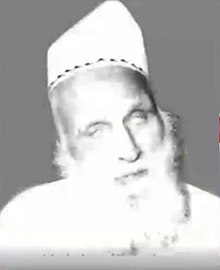Fateh Muhammad Panipati
Fateh Muhammad Panipati | |
|---|---|
 | |
| Personal | |
| Born | 18 January 1905 |
| Died | 16 April 1987 (aged 82) Medina, Saudi Arabia |
| Resting place | Al-Baqi Cemetery |
| Religion | Islam |
| Nationality | Pakistani |
| Alma mater | Darul Uloom Deoband |
| Senior posting | |
Students | |
Fateh Muhammad Panipati (18 January 1905 – 16 April 1987) was a Pakistani Islamic scholar who worked in the field of qira'at (Qur'an recitation methods). He was an alumnus of Darul Uloom Deoband and wrote books including Al-Qurrah al-Marḍiyyah and Inayate Rahmani.
Biography
[edit]Fateh Muhammad Panipati was born on 18 January 1905 (coinciding 12 Dhu al-Qadah 1322 AH) in Panipat.[1] He graduated in the traditional dars-e-nizami from the Darul Uloom Deoband.[2] His teachers included Asghar Hussain Deobandi, Hussain Ahmad Madani, Ibrahim Balyawi, Izaz Ali Amrohi and Muhammad Shafi Deobandi.[3]
In 1947, when Pakistan was established, Panipati migrated there and briefly taught in Ichhra and Pind Dadan Khan.[4] He taught at Madrasah Ashrafiyyah Fayḍ al-Qurʾān in Shikarpur from 1948 to 1956.[4] He moved to Karachi in 1957 at the invitation of Muhammad Shafi Deobandi,[5] and taught at the Nanak Wara branch of Darul Uloom Karachi,[6] for over fifteen years.[5] He was considered a senior scholar of Quranic recitation during his time. Muhammad Taqi Usmani has described him as the contemporary al-Jazari.[7] His students included Abdul Haleem Chishti, Abdush Shakoor Tirmizi, Raheem Bakhsh Panipati and Siddiq Ahmad Bandwi.[8]
Panipati migrated to Medina in 1972 and began teaching in the Al-Masjid an-Nabawi. He spent the last few years of his life in Medina.[5] He visited Lahore for a short while where he suffered from hemiparesis on 20 May 1979, leading him to return to Medina.[9] He died on 16 April 1987 and was buried in Al-Baqi Cemetery. His funeral prayer was led by Ali ibn Abdur-Rahman al Hudhaify.[9]
Literary works
[edit]Panipati wrote seventeen books in Urdu. He wrote Inayate Rahmani, a commentary on al-Qasim ibn Firruh's Ḥirz alAmānī wa Wajh al-Tahānī, commonly known as al-Shatibiyyah.[10] His other works include:[10]
- Al-Qurrah al-Marḍiyyah
- Ashal al-Mawārid fī Sharḥ ʿAqīlat Atrāb al-Qaṣāʾid
- Miftāḥ al-Kamāl
- Nūrānī Qāʿidah
- Tashīl al-Qawāʿid
- ʿUmdat al-Mabānī
See more
[edit]References
[edit]Citations
[edit]- ^ al-Barmawi 2000, p. 236.
- ^ al-Barmawi 2000, p. 237.
- ^ al-Barmawi 2000, p. 240.
- ^ a b al-Barmawi 2000, p. 238.
- ^ a b c al-Barmawi 2000, p. 239.
- ^ Usmani 2020, p. 38.
- ^ Usmani 2020, p. 39.
- ^ al-Barmawi 2000, pp. 241–244.
- ^ a b Baqa 2006, p. 333.
- ^ a b al-Barmawi 2000, pp. 235–236.
Bibliography
[edit]- Baqa, Muhammad Mazhar (April 2006). Hayat-e-Baqa awr Kuchh Yaadein (in Urdu). Karachi: Zawwar Academy Publications.
- Usmani, Muhammad Taqi (September 2020). "YādeiN" [Memoirs]. Al-Balagh (in Urdu). 56 (1). Karachi: Darul Uloom Karachi: 38–39.
- al-Barmawi, Ilyas ibn Ahmad (2000). "فتح محمد". إمتاع الفضلاء بتراجم القراء فيما بعد القرن الثامن الهجري (in Arabic). Vol. 1. Medina: Dār al-Nadwah al-ʿĀlimiyyah. pp. 236–246.
Further reading
[edit]- Multani, Muhammad Ishaq, ed. (2012). Tadhkira ash-Shaykhayn (in Urdu). Multan: Idara Taleefat-e-Ashrafiya.
